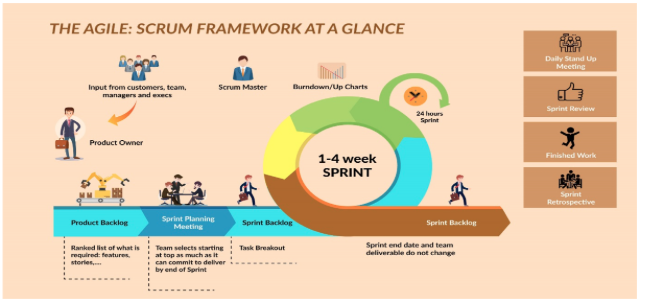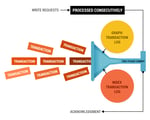Irrespective of the scope, every project should follow a sequence of actions to be controlled and managed. A typical project management process includes the following phases to achieve specific tasks & these phases define the project management lifecycle:

Traditional project management followed the waterfall model. However, waterfall method tends to be slow, costly and rigid due to the various constraints. In many cases, its inefficiencies to adapt the product to the growing market requirements frequently results in a huge wastage of resources and ultimately lead to project failure. The product predictability was always ascertained during last phases of the SDLC.
On the other side, agile has been introduced as a challenge to make software engineering process flexible and efficient. A predictable software is possible at every stage. Agile methodologies provide an iterative approach to software development and contains several smaller cycles – sprints. It has a backlog of items and they are delivered incrementally.
At the end of each sprint, a potentially shippable product augmentation is delivered. Subsequently, with every iteration, new features are added to the product, which results in the gradual project growth. With the features being validated quite early in the development, the chances of delivering a possibly failed product are significantly lower.

Best Practices to Adopt Agile
Product Backlog - Scrum approach helps manage the requirements when our project team has a stack of prioritized and estimated requirements which need to be addressed. New requirements are prioritized by our project stakeholders and added to the stack in the appropriate place. The stack or backlog is initially filled as the result of your requirements envisioning efforts at the beginning of the project. Each iteration or sprint, our team pulls an iteration's worth of work off the top of the stack and commits to implementing it by the end of the iteration.
User Story Mapping involves identifying the users followed by the activities. This involves identifying a backbone which in turn helps in breaking the high-level goal into sub-tasks, alternative tasks exceptions and details. This helps in identifying a proper flow for the user and necessary minimum viable product for the release.
Prioritize and Rank PBI’s - Prioritizing the product backlog and ranking the epics or stories helps in giving a better picture to the customer in implementing and arriving at a minimum viable product. When the team empowers a shared understanding of priorities to move in a uniform direction towards a common goal.
- Continually groom your product backlog
- Apply learnings from the Sprint review
- Have a “Split of work” working agreement in place
Product Backlog Refinement helps keep the backlog clean and orderly. A relaxed way to make Sprint Planning meetings both shorter and more effective is through the consistent use of Product Backlog Grooming Sessions.
Release Planning helps to release product increments. A very high-level plan for multiple Sprints generally 3 to 12 iterations are created during the release planning. Expectations are the features that will be implemented and when completed. It also serves as a base to monitor progress within the project. Releases can be intermediate deliveries done during the project or the final delivery at the end.
Sprint Planning helps to do What can be done in this Sprint (Sprint Goal) and how will the chosen work get done. Sprint Planning is timeboxed to a maximum of 8 hours for a one-month Sprint. By following the daily scrum, the team gets to know what we did yesterday, what do we plan for today, and captures the impediments. It is limited (timeboxed) to fifteen minutes. Scrum master will note down any impediments and will clear in due course.
Sprints - By practicing Sprint model, the team can aim for specific work to be completed and made ready for review. Duration of the Sprint generally should be 2 to 4 weeks. During the sprint, the team holds daily stand up meeting to discuss the progress of the sprint activities. At the end of the sprint, the team presents its completed work to the product owner and stakeholders. The product owner customizes the criteria recognized at the sprint planning meeting to either accept or reject the work.
- Time-boxed sprints producing potentially shippable output
- Shared commitment to sprint backlog between product owner and team
- Short daily meeting to resolve the present issues
- Team members volunteer for tasks (self-organizing team)
At the end of the Sprint, the team holds Sprint Review and Sprint Retrospective. During Sprint Review, the team reviews the work that was completed and the planned work that was not completed, finally team presents the completed work to the stakeholders (the demo). Sprint Retrospective focuses on what went well in the Sprint, what could have been improved and what the team can commit to improve in the next Sprint.
Customer Collaboration - By keeping customers or clients in the loop throughout the whole life cycle, everyone involved will be on the same page and there will not be any shocks at the end or massive rewrites needed because a module or integration wasn’t clear for all parties involved.
Conclusion
Regardless of the meticulous methodologies and techniques we use, Agile projects have proven to increase profits 37% faster and generate 30% more revenue than non-agile projects. High performance teams, flexibility, and productivity achieved through such approach are the significant drivers that motivate more and more organizations to switch to Agile.
Innominds is a dedicated product incubator for technology industry clients seeking help with Design, Technology and Quality Engineering solutions across all stages of their product life cycle. We have deep expertise in Quality Engineering with extensive experience in setting up dedicated and secured Offshore Development / Test Centers with replicated client environments for technology companies and Enterprises, ensuring Quality @ Speed.
Interested! For any demos or POCs, please write to us at marketing@innominds.com and know more about our offerings.



